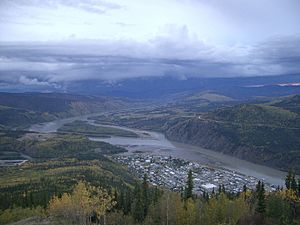Tr'ochëk facts for kids
Tr'ochëk is a special place where the Klondike River and Yukon River meet. For a long time, it was a traditional fishing camp for the Hän people, who are part of the Tr'ondëk Hwëch'in First Nation. This site is located on a flat area of land right where the two rivers join. The city of Dawson City is just across the Klondike River from Tr'ochëk. Today, the Tr'ondëk Hwëch'in First Nation owns and takes care of Tr'ochëk. In 2023, Tr'ochëk became part of the Tr’ondëk-Klondike UNESCO World Heritage Site. This means it's recognized globally for showing how the land changed from being used by Indigenous people to being used by settlers.
Contents
A Long History of Use
People have used Tr'ochëk as a fishing spot for many years. The oldest clues found by archaeologists show that people were there between 1500 and 1700 CE. In the late 1800s, Tr'ochëk was the summer camp of Chief Isaac. He was the leader of the Tr'ondëk Hwëch'in people during the time of the Klondike Gold Rush. The Tr'ondëk Hwëch'in mainly used this camp in the summer. They hunted moose in the nearby flat areas and fished for salmon as the fish swam up the Yukon River.
Nature Around Tr'ochëk
The flat land near the river has many different plants. You can find poplar trees, alder bushes, and willow bushes. There are also open grassy areas. Behind the site, there is a steep hill covered in plants typical of a northern boreal forest. This includes thick moss, spruce trees, and small birch groves. Higher up on the land, mining activities have removed much of the original plants and soil. Only a few spruce trees remain along the edge of the river bluffs.
The Gold Rush and Changes
The Klondike Gold Rush brought big changes for the Tr'ondëk Hwëch'in people. Thousands of gold seekers, called "stampeders," arrived and crowded their summer camp. To avoid the problems this caused, the Tr'ondëk Hwëch'in decided to move. With help from the Anglican Church and the Royal Canadian Mounted Police, they moved a few kilometers downriver. This new place became known as Moosehide.
After the Tr'ondëk Hwëch'in moved to Moosehide (64°05′40″N 139°26′12″W / 64.09444°N 139.43667°W), Tr'ochëk was used by the new settlers. They built bridges connecting the site to Dawson City. For a while, Tr'ochëk was even called Klondike City and was an active part of Dawson. As fewer people lived there, the site was used for growing vegetables. Then, in the 1950s, First Nation people began to settle back at Tr'ochëk.
Protecting a Special Place
In the early 1990s, mining activities at Tr'ochëk led to a legal case. The Tr'ondëk Hwëch'in challenged the Canadian government's right to allow mining on their traditional lands. The Tr'ondëk Hwëch'in officially confirmed their ownership of Tr'ochëk in 1998, as part of their land claim agreement. They also made it a heritage site. Later, on July 19, 2002, Tr'ochëk was named a National Historic Site of Canada. This means it's recognized as a very important place in Canadian history.


